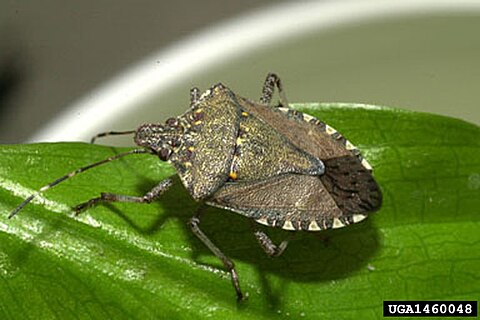The brown marmorated stink bug (Halyomorpha halys) is an insect in the family Pentatomidae, native to China, Japan, Korea and other Asian regions. In September 1998 it was collected in Allentown, Pennsylvania, where it is believed to have been accidentally introduced. The nymphs and adults of the brown marmorated stink bug feed on over 100 species of plants, including many agricultural crops, and by 2010–11 had become a season-long pest in orchards in the Eastern United States. In 2010, in the Mid-Atlantic United States, $37 million in apple crops were lost, and some stone fruit growers lost more than 90% of their crops. Since the 2010s, the bug has spread to the nation of Georgia and Turkey and caused extensive damage to hazelnut production. It is now established in many parts of North America, and has recently become established in Europe and South America.

Adult brown marmorated stink bugs are approximately 1.7 cm (0.67 in) long and about as wide, forming the heraldic shield shape characteristic of bugs in the superfamily Pentatomoidea. They are generally a dark brown when viewed from above, with a creamy white-brown underside. Individual coloration may vary, with some bugs being various shades of red, grey, light brown, copper, or black. The term “marmorated” means variegated or veined, like marble which refers to the markings unique to this species, including alternating light-colored bands on the antennae and alternating dark bands on the thin outer edge of the abdomen. The legs are brown with faint white mottling or banding.
The nymph stages are black or very dark brown, with red integument between the sclerites. First instar nymphs have no white markings, but second through fifth instar nymphs have black antennae with a single white band. The legs of nymphs are black with varying amounts of white banding. Freshly molted individuals of all stages are pale white with red markings. Eggs are normally laid on the underside of leaves in masses of 28 eggs, and are light green when laid, gradually turning white.
Like all stink bugs, the glands that produce the defensive chemicals (the smell) are located on the underside of the thorax, between the first and second pair of legs.

The brown marmorated stink bug is more likely to invade homes in the fall than others in the family. The bug survives the winter as an adult by entering houses and structures when autumn evenings become colder, often in the thousands. In one home, more than 26,000 stinkbugs were found overwintering. Adults can live from several months to a year. They enter under siding, into soffits, around window and door frames, chimneys, or any space which has openings big enough to fit through. Once inside the house, they go into a state of hibernation. They wait for winter to pass, but often the warmth inside the house causes them to become active, and they may fly clumsily around light fixtures. Two important vectors of this pest are the landscape ornamentals tree of heaven and princess tree.
IllFonic pls fix asap pls



